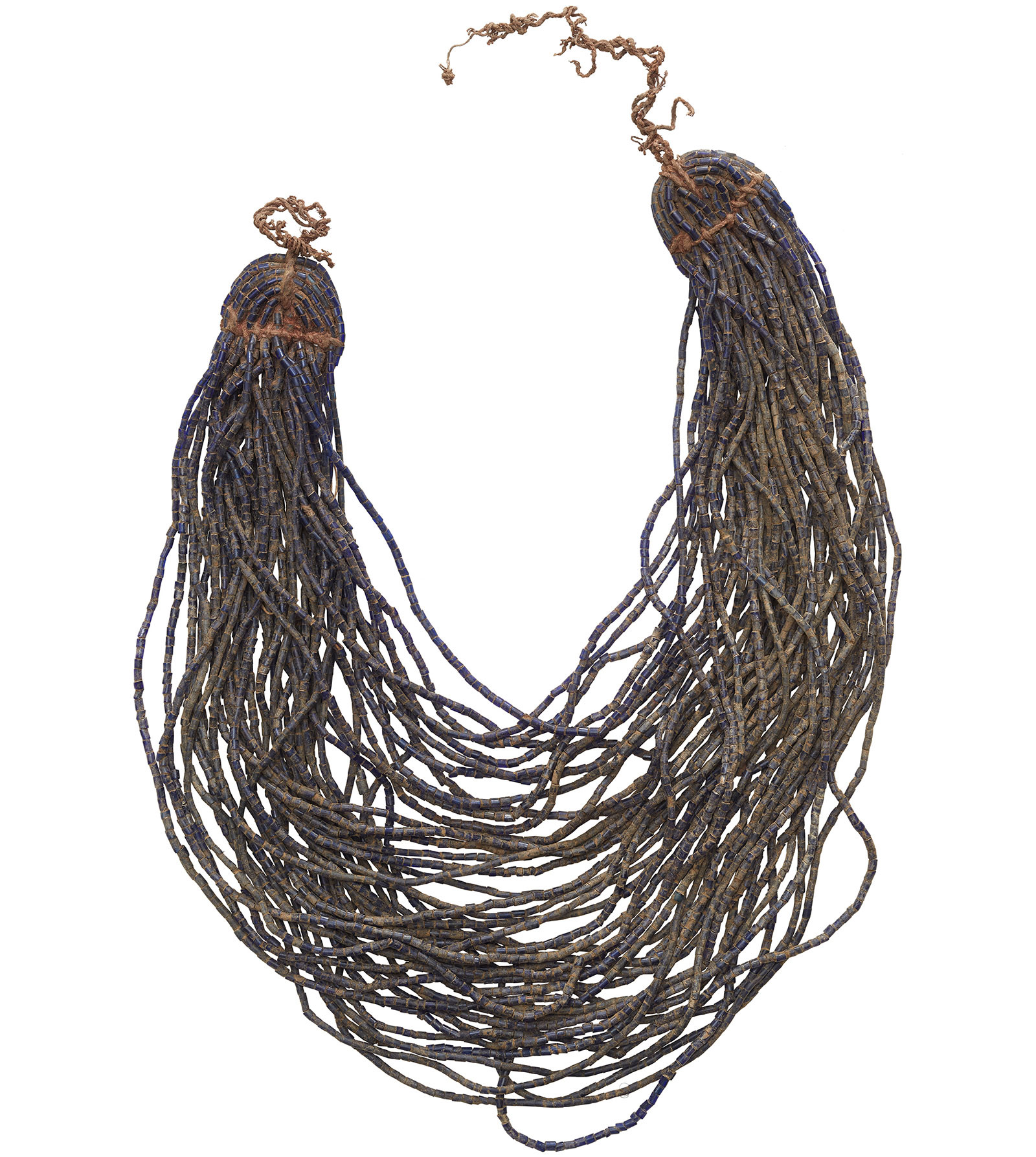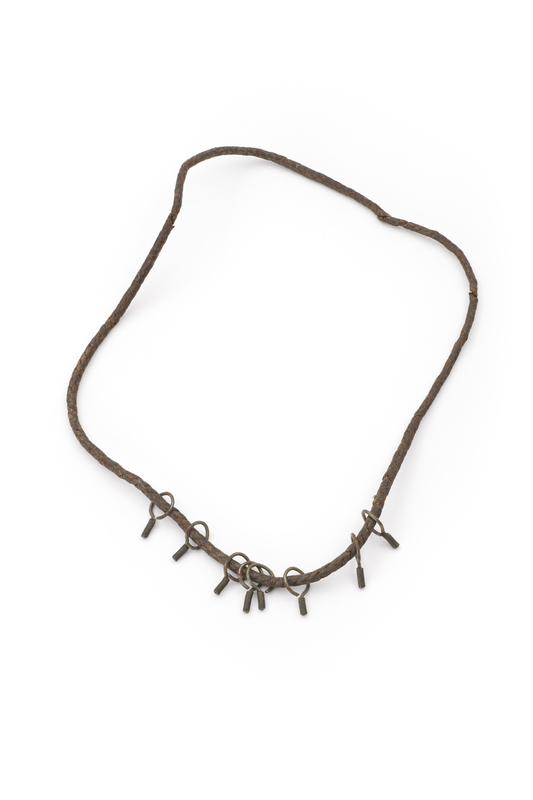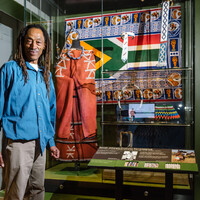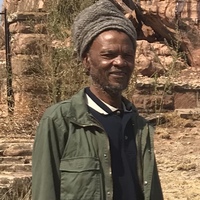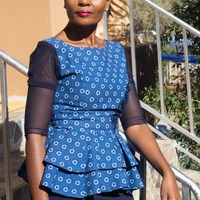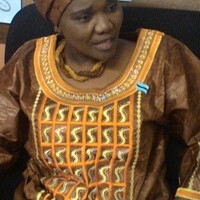Necklace
Item
Title
Necklace
Creator
Unrecorded
Subject
Body Adornment
Description
Physical Description: Necklace consisting of a short twisted leather thong, with eight iron wire pendants attached. The pendants are circular in form with short twisted ends.
Contextual Description: 01:22:15 Our practices will differ, people there will do something different…He says like what I’ve been telling you, you find that in some places, it’s strange practices. [Transcription by KL of MAC_BB_20190817_RPM3 SL Interview with Tshupo Ntono, Village Elder, Language: Setswana with English translations by SL, 2019]
Contextual Description: SL 04:04
found that these things that had some original usage
SL 04:08
or he fashioned them just to make his own beads out of metal
SL 05:00
could easily be a woman's necklace
SL 05:02
Yeah. And again, even though men have necklaces its not very very common to see them
GK 05:10
but I would have thought that this one because it is… metallic things would be for men
SL 04:28
It shows that our people have always done this, you know something, you buy it, and it's meant for this and it stops working, you refashion it into something that you can continually use. It's not like today where we sell scrap metal. Back in the days scrap metal will be used to produce other things that you need...domestic utensils.
WT 05:28
people were very creative I mean you could find that they just picked up this things from somewhere and they thought to turn them together into a necklace
GK 05:39
it is a foreign thing that is from something else.
The above notes are from a transcription by Kathleen Lawther of a discussion between Gase Kediseng, JoAnn McGregor, Nicola Stylianou, Scobie Lekhuthile and Winani Thebele which took place at the Khama III Memorial Museum on the 5th of August 2019. To listen to the full recording please follow the link below.
found that these things that had some original usage
SL 04:08
or he fashioned them just to make his own beads out of metal
SL 05:00
could easily be a woman's necklace
SL 05:02
Yeah. And again, even though men have necklaces its not very very common to see them
GK 05:10
but I would have thought that this one because it is… metallic things would be for men
SL 04:28
It shows that our people have always done this, you know something, you buy it, and it's meant for this and it stops working, you refashion it into something that you can continually use. It's not like today where we sell scrap metal. Back in the days scrap metal will be used to produce other things that you need...domestic utensils.
WT 05:28
people were very creative I mean you could find that they just picked up this things from somewhere and they thought to turn them together into a necklace
GK 05:39
it is a foreign thing that is from something else.
The above notes are from a transcription by Kathleen Lawther of a discussion between Gase Kediseng, JoAnn McGregor, Nicola Stylianou, Scobie Lekhuthile and Winani Thebele which took place at the Khama III Memorial Museum on the 5th of August 2019. To listen to the full recording please follow the link below.
Publisher
Making African Connections
Date
Pre 1899
Type
PhysicalObject
Format
Whole: 228.6 mm
Animal; Iron
Identifier
R4007/29
Source
Collected by Reverend William Charles Willoughby, a Christian missionary, in what was then the Bechuanaland Protectorate (1885-1966). It is now the Republic of Botswana, having gained independence from Britain in 1966.
From 1889-92 Willoughby was pastor at Union Street Church, Brighton (now The Font pub). From 1893 to 1898 he worked for the London Missionary Society in Bechuanaland. He assembled this collection of objects during this period. This was a period of social and technological changes and these objects represent traditional lifestyles and skills, rather than the contemporary lives of the people Willoughby met.
Willoughby's collection was loaned to Brighton Museum in 1899 when he returned to the UK. The loan was converted into a donation in 1936, and accessioned as acquisition R4007.
Some objects were re-numbered with the WA (World Art) numbering system in the 2000s. These numbers have been reverted to the original R4007/... numbers where possible for consistency in 2019.
From 1889-92 Willoughby was pastor at Union Street Church, Brighton (now The Font pub). From 1893 to 1898 he worked for the London Missionary Society in Bechuanaland. He assembled this collection of objects during this period. This was a period of social and technological changes and these objects represent traditional lifestyles and skills, rather than the contemporary lives of the people Willoughby met.
Willoughby's collection was loaned to Brighton Museum in 1899 when he returned to the UK. The loan was converted into a donation in 1936, and accessioned as acquisition R4007.
Some objects were re-numbered with the WA (World Art) numbering system in the 2000s. These numbers have been reverted to the original R4007/... numbers where possible for consistency in 2019.
William Charles Willoughby
Botswana, Southern Africa, Africa
1893-1898
Space/Place
Botswana, Southern Africa, Africa
Cultural Group: Tswana
Rights
Creative Commons Attribution-ShareAlike 4.0 International

